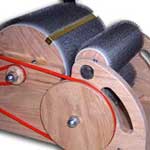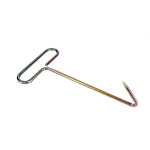Selecting a Carder
Selecting a Drum and Hand Carder, Buying a Drum and Hand Carder & General Information
This page will give you an introduction to selecting a drum Carder, selecting hand carders, buying a drum carder, buying hand carders touching on the types of carders, technical terms, attachments, options and considerations in choosing a carder.
- Selecting a Drum Carder
- Buying a Drum Carder
- Drum Carder Information
- Selecting Hand Carders
- Buying Hand Carders
- Hand Carder Information
- General Carding Information
General information
Carding of wool can either be done "in the grease" or not, depending on the type of machine and on the spinner's preference. "In the grease" means that the lanolin that naturally comes with the wool has not been washed out, leaving the wool with a slightly greasy feel.
Hand carders (and small drum carders too, though the directions may not recommend it) can be used to card lanolin rich wool. A major benefit of working with the lanolin still in the wool is that it leaves you with soft hands. Carding is the processing of brushing raw or washed fibers to prepare them as textiles.
A large variety of fibers can be carded, anything from dog hair, to llama, to soy fiber to polyester. Cotton and wool are probably the most common fibers to be carded.
Not all fibers are carded; Flax and bast, for example, are retted then threshed. Carding is used to take unordered fibers and prepare them for spinning or to produce webs of fiber to go into non-woven products such as needle felting. Carding can also be used to create blends of different fibers or different colors. The process of carding mixes up the different fibers, thus creating a homogeneous mix of the various types of fibers, at the same time as it orders them and gets rid of the tangles.
In addition to spinning, weaving and felt making, carded fibers can be used in a variety of other projects. Many rug makers use unprocessed yarn and slivers of rovings look great when couched into embroidery designs or added to sewing projects as needle felted embellishments. Drum Carders have rollers and systems designed to remove some vegetable contaminants from the wool. The two main ways to card fibers are by hand and by machine.
Watch this video!

Hand Carders
Hand Carding: Hand Carders are a pair of wooden paddles covered in a pin cloth. The carders are not dissimilar to dog brushes or teasel combs. The pins are typically equally spaced over the cloth and when the carders are pulled against each other the fibers get pulled into smooth locks. When commercially prepared, these long locks of smooth fibers are referred to as ‘rovings’.
See our large selection of hand carders....
Hand carders are used two at a time to brush the wool between them until all the fibers in a bunch more or less align in the same direction. To card, the person carding holds a carder in each hand. The carder in their non-dominant hand (left for most people) rests on their leg. They place a small amount of fiber on this card and pull the other carder through, while taking care to catch some of the fibers. By catching some fibers on the moving card, the fibers are separated, which allows vegetable matter to fall out, and they are aligned.
Catching too many fibers makes it hard to pull the carders apart. This process, repeated many times, transfers small amounts of the wool to the other carder. Once all the wool has been transferred, the person carding repeats this process until all the fibers are aligned and the fiber is satisfactorily clean of debris.
Hand carders come in a wide variety of sizes, from ones two by two inches to ones four by eight inches. The small ones are called flick carders, and are used just to flick the ends of a lock of hair, or to tease out some strands for spinning off. Density of the teeth, and shape of the carders also varies. For finely carded fiber, one uses carders with more teeth. The type of fiber, its length, weight and characteristics, can also determine how many teeth are needed per inch on the carders.
Hand carders can be either flat backed or curved, which is a matter of personal preference.

See our large selection of hand carders....
Selecting Hand Carders
There are two basic types of hand carders, wool and cotton. Carders are available in both flat-back or curved back styles. Size is also a factor to consider. Small carders won't hold as much fiber but are physically easier to handle. If you don’t have any upper arm strength a smaller size carder would be appropriate but for most folks, a regular size will be what you will want.
There are carders with large, widely spaced teeth and carders with small, fine, and closely spaced ones. The ones with the larger, widely spaced teeth are better for working with fiber that is coarse, tangled, or very lumpy. Carders with fine, closely set teeth are better for fiber that has already been carded once, but needs further carding, or for fibers that are very delicate, such as angora or cotton. One of the best all-around choice for a beginner is a pair of medium or fine gauge wool carders.
Most wool hand cards are made for universal use. They do all wool and finer fibers. Cotton hand cards are specific to the finer fibers such as cotton, cashmere, alpaca and angora and will do a better job on these finer fibers. (See- Selecting a Carding Cloth below)

Drum Carders

Selecting a Drum Carder
Drum Carding Accessories
DOFFER/CLEANING BRUSH:
Curved back brush used to clean hand carders and drum carders

DOFFER STICK/DOFFER PIN:
For removal of batt from drum carder

KNUCKLE-SAVING BATT PICKER:
A much needed variation of the doffer stick, this tool saves your knuckles from painful contact with the teeth of your drum carder when removing the batt from the large drum.

TEASING TOOL:
You might call this a single flat hand card, but you use it in a different way. Clamp the tool near your drum carder or even near where you are hand carding and pull your wool over the teeth to open ends and begin the process of cleaning and carding. Both hands are free to do this since the tool is clamped. Makes for faster, more efficient carding.

DRUM CARDER BRUSH ATTACHMENT:
The Fine Fiber Brush Attachment increases the carder's ability to card mohair, angora, alpaca and other fine fluffy and low crimp fibers that tend to collect on the small licker-in drum. With all fibers, a thicker, denser and more uniform batt is produced by using the attachment. Highly Recommended!
Selecting Carding Cloth
- Coarse: 45-54 teeth per square inch (tpi), used for more open fibers.
- Regular: 72 teeth per square inch, Can be used for coarse and mid-range fibers such as Cheviot, Romney and adult Mohair. Useful for carding wool such as Border Leicester to get a deep batt. NOT recommended for fine fibers.
- Fine: 90-120 teeth per square inch. For most fibers, again NOT recommended for fine fibers.
- Extra Fine: 190-255 teeth per square inch. For ALL fibers, especially very fine varieties. Can be used for Cotton, Merino, Llama, Alpaca, Cashmere, Dog Hair and other exotics.
Tpi stands for teeth per square inch. It is used in reference to the carding cloth used on your drum carder, hand carders, or flicker. How many you need depends on what fiber you want to card. Keep in mind that not one set will work perfectly for every fiber but, for the most part a pair ranging from 72-112 TPI will work on most wool.
Wash & Prepare Fleece
General information: Carding of wool can either be done "in the grease" or not, depending on the type of machine and on the spinner's preference. "In the grease" means that the lanolin that naturally comes with the wool has not been washed out, leaving the wool with a slightly greasy feel. Hand carders (and small drum carders too, though the directions may not recommend it) can be used to card lanolin rich wool.
A major benefit of working with the lanolin still in the wool is that it leaves you with soft hands.

